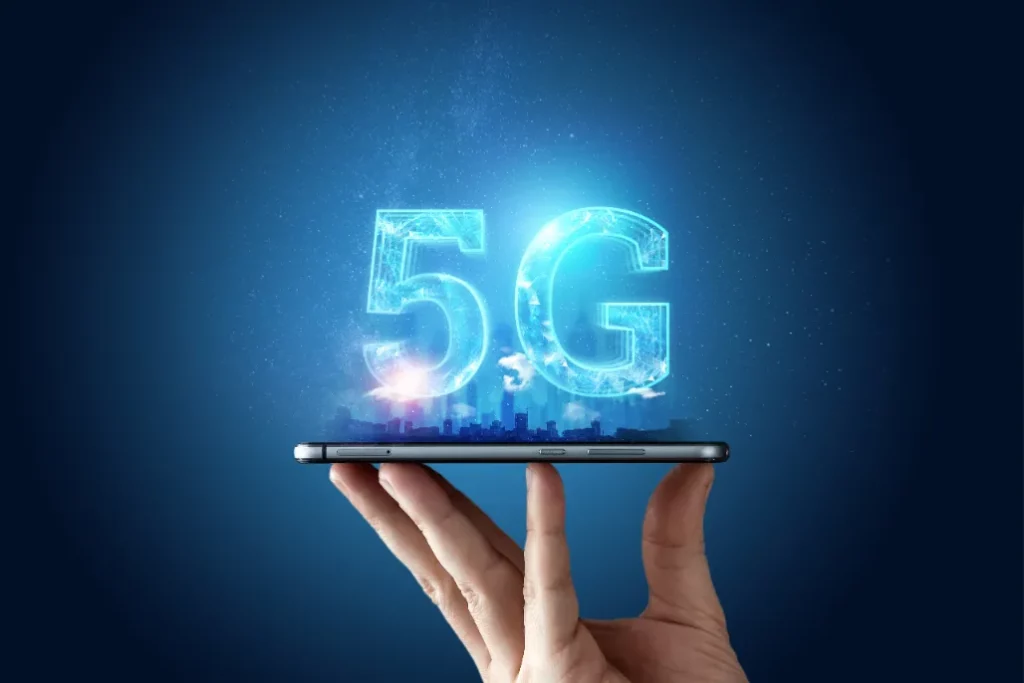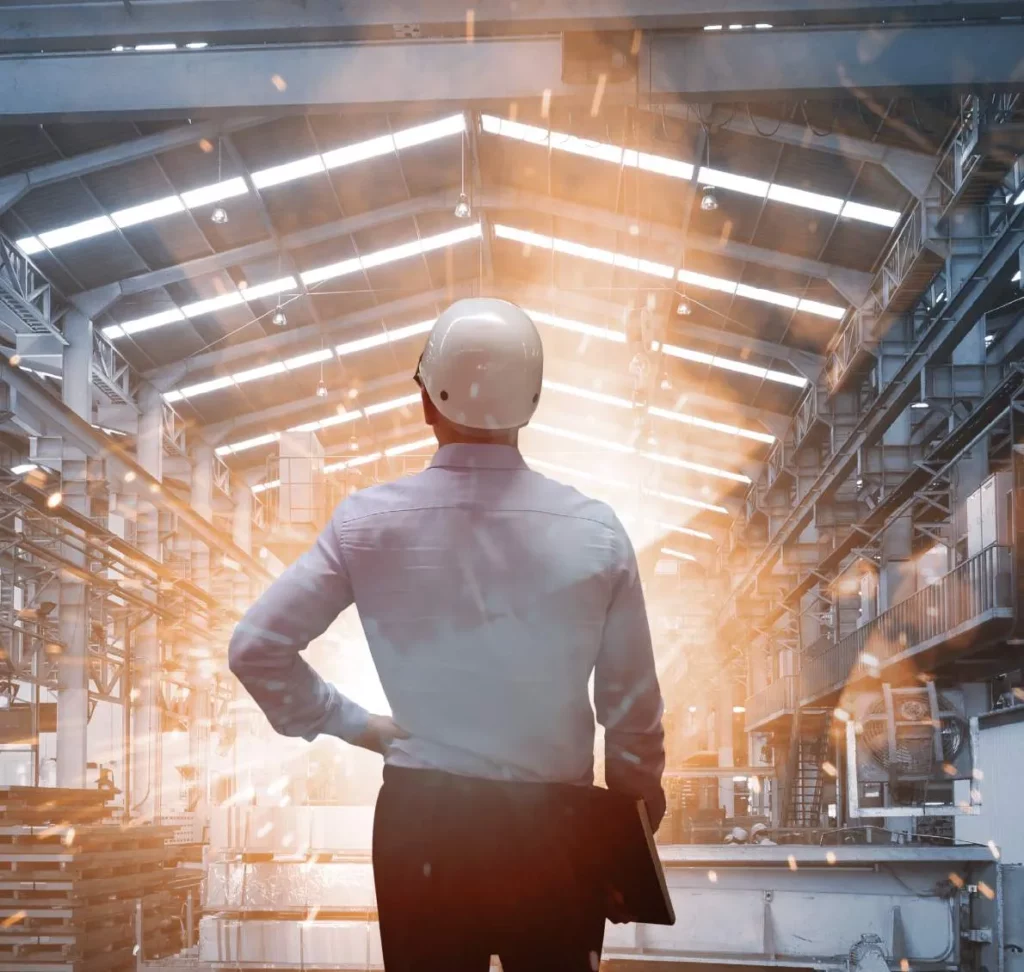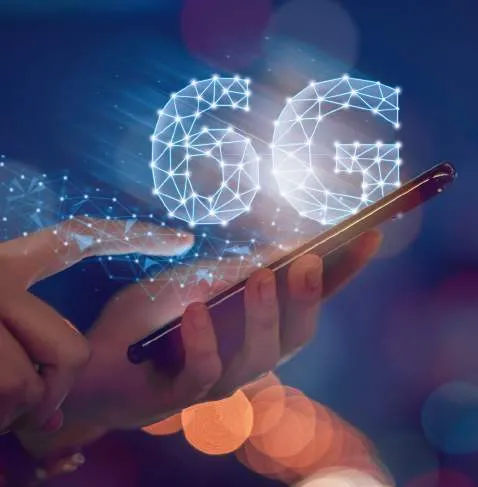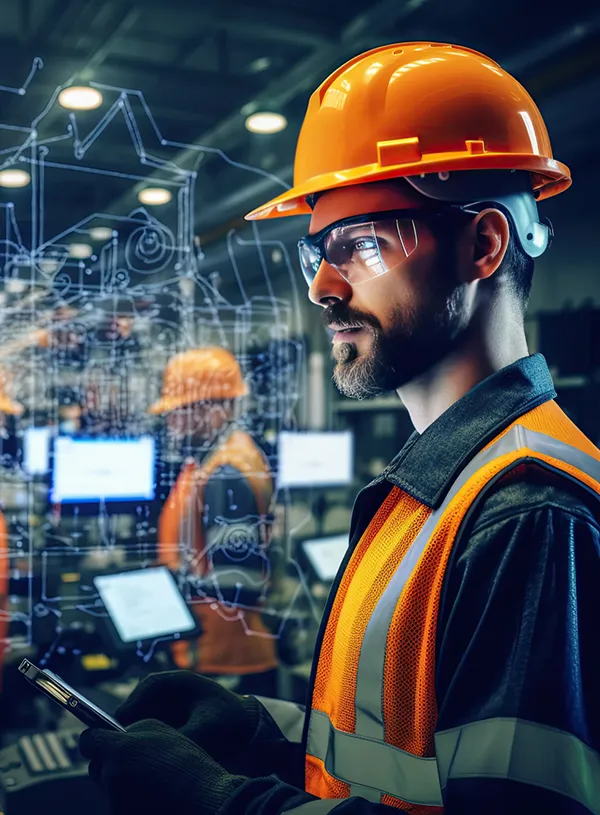IFM Innovators
14 min read
Table of contents
Module I - Innovation
- 1. What is Maintenance 5.0 and how 5G can help
- 2. What sustainable smart technology trends are on the rise
- 3. Why IMMPs are being chosen over CMMS
- 4. Everything about the potential of AI in facility management
Table of contents
Module I - Innovation
- 1. What is Maintenance 5.0 and how 5G can help
- 2. What sustainable smart technology trends are on the rise
- 3. Why IMMPs are being chosen over CMMS
- 4. Everything about the potential of AI in facility management
What is Maintenance 5.0 and how 5G can help
Over the last decade, the expression “Industry 4.0” became a synonym for the 4th Industrial Revolution, which saw the emergence of cyber-physical systems. It also became a synonym for the profound digital transformation we’ve experienced. Technologies that were once considered “disruptive” like cloud computing, NFC, wireless sensors, or IoT are well-established in our day to day. We’re more connected, factories are more automated, and there’s less downtime than ever before.
At the core, Industry 4.0 was all about mass production and maximum efficiency. The goal with Industry 5.0 is to achieve mass customisation, deliver a good customer experience, and see the return of manpower to factories. It’s widely believed that it will increase sustainability and resilience, an idea that gained even more traction during the pandemic. According to the European Commission:
“Industry can help achieve societal goals beyond jobs and growth, and become a resilient provider of prosperity.”
– Industry 5.0: Towards a sustainable, human-centric and resilient European industry
Instead of constantly running after technology, the idea is to make technology work with us. Humans and machines are paired like co-workers to increase efficiency, integrate workflows, avoid waste, improve logistics, and create high-quality custom products. Industry 5.0 also brings sustainability to the forefront, with human-based 6Rs: reconsider, refuse, reduce, reuse, recycle, and repair.
The hyper customisation of Industry 5.0 can be applied to digital drugs (before you get the wrong idea, they’re sounds that are capable of changing wave patterns and sending the brain into a state of meditation), personalised
medicine, smart fashion, and intelligent transportation systems. Plus, contributes to developing further concepts like smart factories, innovative ecosystems, and the green economy. The big question is, how is all of this coming about?


The main technologies enabling Industry 5.0
While it is true that Industry 5.0 prioritises customisation, the achievements of Industry 4.0 won’t go away. With the lessons we’ve learnt, it’s safe to say it will be all about “maximum customisation at the lowest cost and maximum accuracy”. These are the seven main technologies supporting Industry 5.0.
Edge computing

It’s generally assumed 5G and faster networks will be enough to power real-time apps and decrease latency. Spoiler alert: they won’t, and that’s where edge computing comes in. “Edge” will bring storage closer to the data sources, which will impact response times and require less bandwidth, finally allowing billions of devices to be connected at the same time. The goal is to end latency, enabling real-time apps, connected assets, and smart homes/facilities.
Digital twins

Digital twins are a virtual representation of a physical object or process. They will improve product design, leading to fewer faults and, hopefully, fewer failure modes too. In our particular maintenance and FM bubble, we’ll likely use them to make risk assessments (for example, to perform an FMEA) or to simulate how a repair needs to be carried out. Digital twins are expected to reduce production costs and boost predictive maintenance.
Collaborative robots

Robots are not a threat – they’re an asset. Collaborative robots (or “cobots” for short) will increase productivity, robustness, and enhance technician dexterity. Among these cobots we’ll find:
• super-strength operators (operators + exoskeleton)
• augmented operators (operator + AR)
• virtual operators (operator + virtual reality)
• healthy (operator + wearable tracker)
• smarter (intelligent personal assistant)
• collaborative (operator + collaborative robot, like an assistant)
• social (operator + social networks) analytical (operator + big data analytics)
Internet of Everything (IOE)

The Internet of Things (IoT) is a network of connected physical devices. And, for the most part, it’s already the world we live in. The Internet of Everything (IoE) expands beyond “things” to include people, processes, and data. Within this next-generation IoT, we expect to improve asset productivity, reduce downtime, cut down costs, and develop “reflective intelligence”, which is the whole system’s ability to self-manage, self-monitor and self-modify.
Blockchain

We’ve talked about potential applications of blockchain outside of cryptocurrencies for ages, but they never seem to materialise when it comes to maintenance and facility management. Industry 5.0 may change that for good, using blockchain as a method of decentralised management. For example, it will be possible to set up a “smart contract” and a “shared ledger” between you, your customers and your providers.
6G (and beyond)

Implementation of 5G may just have started, but intelligent 6G networks are already underway. They will probably have a complex layered architecture to optimize performance, support augmented and virtual reality better, and enable knowledge discovery (data is reconfigured or recategorised to produce new explicit knowledge). Much like Industry 5.0, Nature Electronics predicts 6G will be “human-centric”.
Of course, these technologies all need to interact with one another to make it work.
But you’ll be happy to know that Repsol, for example, is already employing a mix of blockchain, cyber-physical systems and robots to automate tasks and “alleviate physical presence” in dangerous sites, thus protecting its workers. And that’s what Industry 5.0 is all about.
Reality check: what are the challenges of Industry 5.0?

Security & privacy
Technology also has downsides. Arguably, the three biggest challenges we will face are security, reliability, and privacy. According to a 2018 study:
89% of companies have data security and privacy concerns regarding predictive maintenance.
We can only assume they will have the same reservations regarding any software that requires data collection and data analysis, fearing it might make them vulnerable. There is no easy fix for these problems since cybersecurity is ever-evolving and digital structures need their own maintenance too. One thing we advise you to do is to check the whole supply chain – make sure every supplier and software provider has a secure firewall and ensures data protection. Don’t be shy to include it in the contract or in the SLA.
Skilled workforce
If robots take over labour-intensive tasks and humans do all the thinking, we’ll need a skilled workforce. In fact, maintenance managers are already struggling with the lack of skilled personnel; Industry 5.0 will only exacerbate the problem.
Only:
29% of facility managers consider their technicians “very prepared”,
31% of companies outsource because “skilled individuals are hard to find”,
41%of manufacturing companies see “the lack of resources or staff” as their biggest challenge.
Upskilling is the obvious solution for these problems, but not the only one. Apart from continuous training and taking time off work to train these new skills, managers also need to make sure every technology they decide to invest in suits their teams. Software shouldn’t be ‘stiff’ anymore. It should be flexible, customised to each operation, and intuitive. Likewise, onboarding should be as thorough as possible.
Regulatory compliance
If we’re making Industry 5.0 human-centric and sustainable, countries will probably try to pass legislation to enforce worker’s rights, regulate human-robot coworking, and agree on a “Green Deal” . Since supply chains are global, these industry standards need to apply worldwide and companies need to commit to Sustainable Development Goals.
However, this also puts pressure on businesses to be more transparent about their business practices. Tracking data about your operations, as well as blockchain (which makes records impossible to change), are two great starting points. When it comes to FM and Maintenance, you can count on integrated software to generate reports you can share with stakeholders.
What does Maintenance 5.0 look like?
With Industry 5.0 becoming a reality, maintenance follows suit. Maintenance 5.0 will likewise follow a human-centric approach, in harmony with software and hardware. It’s increasingly customisable to each facility and equipment, safer and more intuitive for technicians, and less disruptive of normal operations.
It’s impossible to seek harmony between people and software without comprehensive tools. Maintenance 5.0 relies heavily on integrated platforms accessible to managers, technicians, end users and intelligent devices. This centralises preventive maintenance plans and reactive work orders – either generated by humans or by the system itself – which means every task is accounted for. The information collected during day to day operations flows seamlessly to generate automatic orders from providers, send invoices to clients, and connect maintenance to the company’s wider goals.

Predictive maintenance is predicted (no pun intended) to become a cornerstone of Industry 5.0, along with IoT and cloud computing. But we’ll argue this triad is already key for companies who seek efficiency and reliability. According to a 2018 report, European companies who transitioned to predictive maintenance increased availability by 9%, decreased costs by 12%, reduced safety, environmental and quality risks by 14%, and extended asset lifetimes by 20%.
However, predictive maintenance will become more accurate, and other technologies will enable its evolution towards prescriptive maintenance. Prescriptive maintenance is cognitive, and it relies on your maintenance data (like records, condition-monitoring information and predictive algorithms) to run “what-if” scenarios. It then provides suggestions to avoid losses and downtime.
Besides, maintenance will likely evolve into another AI-implemented, AI- enabled process, anchored by big data analytics and set up with the help of subject matter experts (SMEs) and consultants. This will probably look like an expansion of what we currently know as “Maintenance-as-a-Service”.

And which technologies and trends support Maintenance 5.0?
Iot, cloud computing, and automation
Technologies like the Internet of Things (or its natural evolution, the Internet of Everything [IoE]), cloud computing and automation will continue to leave their mark on maintenance software.
Agile supply chain
Businesses should be able to track the location and condition of each part, analyse data, and optimise their warehouse space and inventory better. Efficient logistics enable maintenance teams to avoid waste in unnecessary waiting, transportation, and motion.
Customisable Intelligent Maintenance Management Platforms (IMMPs)
Connecting all your devices and sensors using IoT is a good start, but it’s not enough to be “agile”. IMMPs allow you to integrate maintenance software with other tools (e.g. business intelligence, accounting, communication or analytics tools) to create data flows, increase efficiency and spot improvement opportunities.
Virtual and augmented reality
Virtual and augmented reality can create immersive experiences and interfaces for technicians, which helps them to simulate repairs and make a previous walkthrough. Apart from this practical approach, VR and AR can also revolutionise training and onboarding.

Wearables
Wearables are nothing new. However, their potential to be used in maintenance remains untapped: smart fabrics (for example, UV protective clothing), robotics suits for superhuman strength, or even smart glasses that give technicians step-by- step instructions on how to assemble and repair an asset.
Additive manufacturing
Additive manufacturing (or 3D printing) might be one of the most disruptive technologies to supply chains. Instead of waiting for a part to arrive, providers might send you a 3D model to print on your own facilities. Besides, it opens lots of possibilities for customisation, which is what Industry 5.0’ is all about.
Cognitive cyber-physical systems
Cyber-physical systems (CPS) are the backbone of Industry 4.0, but their cognitive sibling will blend technology and physical components better. Expect greater resilience due to their ability to self-adjust to variations and self-optimise for disturbance, along with collaborative decision-making with humans.
Cobots
Cobots differ from robots in the sense that they are true human companions. Because they are extremely cognitive, they can sense and understand human presence. The goal is to use these ‘cobots’ for repetitive and labour-intensive tasks and free our human brains for customising products and critical thinking. In the future, every maintenance technician may work along with its own cobot.
Excellent and computerised customer service
It wouldn’t be fitting if the change was only technical. Industry 5.0 is human-centric, so we’ll need to push for greater and faster customer service.
Beyond 5.0
Did you think we were done? Not quite. After 5.0, there will be an Industry 6.0, an Industry 7.0, and enough revolutions to last until the Sun becomes a red giant star. What the future has in store is still anyone’s guess, but we’ll bet on the massification of quantum computing, new regulations regarding human- machine co-working policies, global industry standards, and yes, the rise of robot rights too. And we’re here for it!
The potential of 5G technology in Maintenance
We have been hearing about 5G for a long time. It promises unprecedented speed, seamless connection, network connectivity even in areas that still have no coverage, virtual reality, autonomous cars and, to put it briefly, almost a second invention of the wheel. But promises can be broken. Therefore, we decided to investigate the potential of 5G technology for Maintenance and Facility Management in depth. Will technicians really experience this extraordinary connectivity in the field, even in hard-to-reach areas?
What are the differences between 4G and 5G?
Without going into too much technical detail, 4G and 5G use different frequencies. 5G uses higher frequencies, so it can offer faster download speeds. It can reach up to 10 Gbps, which means something like downloading 800MB in a second.
As well as being faster, it also has a lower latency. Those little “lags” – which we don’t always experience in everyday life, but that can mean game over in a streaming game – are almost gone. That latency, which today ranges between 25- 35 milliseconds, can drop to 5. That value, practically negligible, paves the way for telemedicine, surgeries, and remote driving, for example.
While the differences in speed and latency are the most obvious, 5G is also expected to be able to support more devices connected at the same time. In theory, it will be possible to have one million devices per square kilometre. This connectivity will enable a real boom in Industry 4.0 and trigger mass adoption of smart devices, including in our daily lives.
So, what’s the catch with 5G?
5G’s high-frequency waves have a much shorter range. While 4G has a range of up to 10 miles (approximately 16 km), 5G only has a range of 1000-1500 feet (304-457 metres). As if that wasn’t enough, buildings, walls, towers, and trees can block or absorb the signal of the high-frequency waves. So, there is a need to renew the entire telecommunications infrastructure.
Simply put: 5G sounds great for Pokémon Go, but it doesn’t (yet) allow you to hunt for breakdowns without delays. If you were hoping to get coverage in lift shafts, underground floors, and other places with poor coverage, the solution is not immediate. To work, 5G will need Distributed Antenna Systems (DAS), possibly with several smaller remote units. DAS already exist and are also compatible with 3G and 4G networks.
In countries where 5G coverage is more developed, such as the United States, Japan, China, and South Korea, solutions have been sought to spread antennas throughout cities without completely distorting the urban landscape. Ericsson has already developed several solutions to hide “small cells” under our noses: on manhole covers, lampposts, MUPIs, or bus stops.
These two factors explain why the implementation of 5G has been so slow. On the one hand, it requires a tremendous investment in new infrastructure. The most populated urban areas offer the highest return, while more remote areas (where telemedicine, for example, could be extremely useful) come last. On the other hand, there is also the need to develop 5G-enabled devices and figure out how to best integrate them into our lives and our cities.
Is 5G harmful to people?
Given that we will all have to live within 450m of an antenna, there has been some debate about the potential health risks. An article by Deloitte compiled the main doubts about 5G and came to the conclusion that the risks are similar to those of many other technologies we already use. After all, computers and microwaves also use electromagnetic frequencies.
The World Health Organization is more cautious. While it acknowledges that there is no evidence that 5G is harmful to health if exposure is within established limits, it warns about the lack of studies on the subject. For now, it only rules out the possibility of causing problems in the brain, as some articles have suggested. If it has effects on us, possibly they will be on the skin and eyes.
What can we expect from 5G in Maintenance and Facility Management?
The impact of 5G in Maintenance
Realistically, what can we expect from 5G in Maintenance and Facility Management? Given all the features we have already explained, the greatest potential of 5G is in predictive maintenance and prescriptive maintenance. It allows more equipment to be connected simultaneously, systems to be further integrated, and quality data to be obtained without latency. It also paves the way for remote repairs with augmented reality. We have every reason to believe that 5G – and the expansion of IoT to all sides of the business, from suppliers to the end of the production line (in the case of manufacturing) – will help to reduce downtime, increase asset reliability, and improve quality control. However, due to the limitations we have addressed, it may take some time for technicians on the field to feel the true impact of 5G, without network constraints.
The impact of 5G on Facility Management
In FM, it is a double-edged sword. Even if it enables intelligent and increasingly efficient buildings, it also brings operational challenges. The entire structure that supports 5G will join the long list of assets that FM managers usually have under their responsibility. As of now, they must already consider 5G compatibility when choosing or replacing equipment. One of the major responsibilities of facility managers will be to ensure mobility and connectivity within buildings. To do this they will need to circumvent the obstacles that can block 5G, either through technology that already exists, such as DAS or with alternatives that emerge in the meantime. Conference rooms, concert halls, and public spaces, where more devices are concentrated, will need dedicated access nodes.
Should you worry about 5G?
Yes. Despite still being at an early stage of implementation in the UK, it is already important to prepare our infrastructures for the upcoming change and choose equipment that is ready for it. Don’t compromise your future!
Sources
Ackerman, Evan. (10th December 2021). Sarcos Demonstrates Powered Exosuit That Gives Workers Super Strength. Retrieved 21st October 2021 from Link
CXP Group. (May 2018). Digital Industrial Revolution with Predictive Maintenance: Are European businesses ready to streamline their operations and reach higher levels of efficiency?. Retrieved 21st October 2021 from Link
Dang, S., Amin, O., Shihada, B., Alouini, M. (2020) What should 6G be? Retrieved 21st October 2021 from Link
European Commission. (2021). Industry 5.0 – Towards a sustainable, human-centric and resilient European industry. Available from Link
Yang, H., Alphones, A., Xiong, Z., Niyato, D., Zhao, J., Wu, K. (23rd October 2021). Ar-tificial-Intelligent-Enabled Intelligent 6G Networks. Retrieved 21st October 2021 from Link
McLeman, A., Smith, J., Parker, K. (23rd June 2021). The maintenance function, like manufacturing itself, is a rapidly changing environment. Retrieved 21st October 2021 from Link
PwC. (2018) Predictive Maintenance 4.0 – Beyond the hype: PdM 4.0 delivers results. Retrieved 21st October 2021 from Link
Reddy, P.K., Pham, Q., Prabadevi, B., Deepa, N., Dev, K., Gadekallu, T.R., Ruby, R., Li-yanage, M. (2021). Industry 5.0: A Survey on Enabling Technologies and Potential Applications. Available from Link